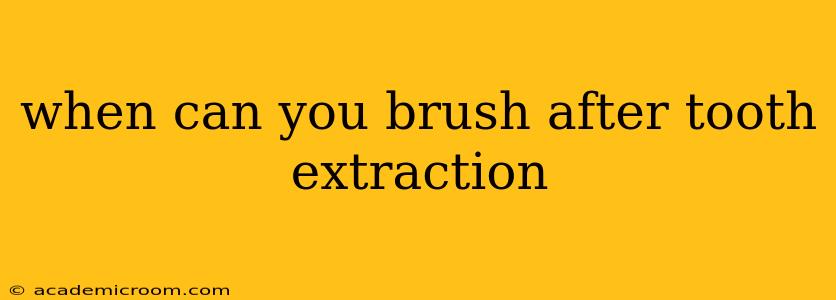Losing a tooth, whether through extraction or other means, can be a disruptive experience. Knowing when and how to care for your mouth afterward is crucial for proper healing and preventing complications. One of the most frequently asked questions is: when can you brush after tooth extraction? The answer isn't a simple one-size-fits-all, but this guide will provide you with the information you need to make informed decisions about your oral hygiene.
How Long Should I Wait to Brush After Tooth Extraction?
The general recommendation is to wait at least 24 hours after a tooth extraction before brushing near the extraction site. This allows the blood clot to form properly, which is essential for healing and preventing a painful and potentially serious complication called dry socket. Brushing too soon can dislodge the clot, leading to exposed bone and nerve endings.
However, it's important to understand that this is a general guideline. Your dentist or oral surgeon may provide specific instructions based on your individual case, the complexity of the extraction, and your overall health. Always follow their advice.
What About Brushing the Rest of My Teeth?
While you should avoid brushing directly on the extraction site for at least 24 hours, you should still brush the rest of your teeth as you normally would. Maintaining good oral hygiene in the rest of your mouth is vital for preventing infection and promoting overall oral health. This helps to reduce the risk of bacteria spreading to the extraction site.
Can I Rinse My Mouth After Tooth Extraction?
Gentle rinsing is usually recommended, but again, wait at least 24 hours before doing so. After the initial 24-hour period, you can gently rinse your mouth with salt water (a half-teaspoon of salt dissolved in a glass of warm water). This helps to keep the area clean and can promote healing. Avoid vigorous rinsing or using mouthwashes containing alcohol, as these can irritate the wound.
What if I Develop Dry Socket?
Dry socket, also known as alveolar osteitis, is a painful complication that can occur after tooth extraction. It's characterized by exposed bone in the socket and can be quite debilitating. If you experience intense pain, a foul odor, or see exposed bone in the extraction site, contact your dentist or oral surgeon immediately. They can provide treatment to alleviate the pain and promote healing.
How Should I Brush After the Initial 24 Hours?
After the initial 24-hour waiting period, you can resume brushing gently around the extraction site. Use a soft-bristled toothbrush and avoid scrubbing or applying excessive pressure. Focus on gentle brushing movements to prevent dislodging the blood clot.
What Kind of Toothbrush Should I Use?
A soft-bristled toothbrush is always recommended, especially after a tooth extraction. The softer bristles will be gentler on the gums and healing tissues.
When Can I Floss After Tooth Extraction?
Similar to brushing, it’s best to avoid flossing near the extraction site for at least 24 hours. After that, you can resume flossing, but be extremely gentle around the area.
This information is for general guidance only and does not constitute medical advice. Always consult with your dentist or oral surgeon for personalized instructions and care after your tooth extraction. They can provide the most accurate and up-to-date information specific to your situation. Taking care of your oral health post-extraction is crucial for a successful recovery.
